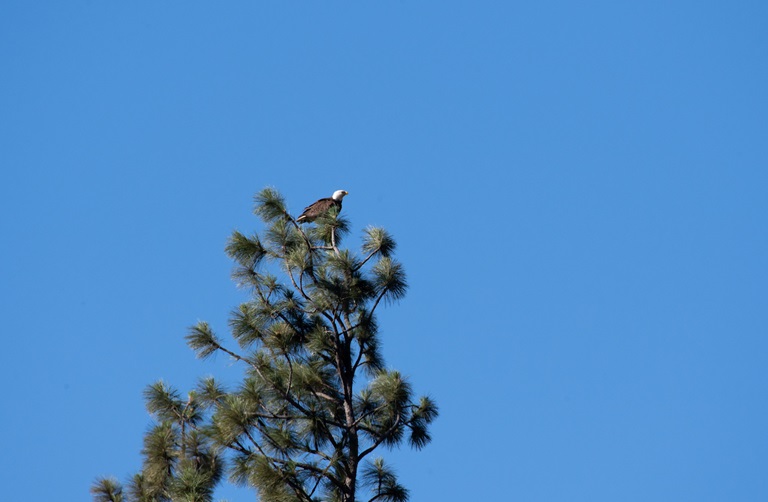Numbers Increase for Lake Oroville Bald Eagles
A bald eagle perches near her nest along the shoreline of Lake Oroville in June 2020. DWR/2020
Seven nesting pairs of bald eagles who have made the Oroville area their home are once again raising families. Environmental scientists from the Department of Water Resources (DWR) Oroville Field Division have been eagerly watching the development of the nine new eaglets – an increase from the eight eaglets spotted in 2019.
The chicks have been spotted around Lake Oroville and in the Oroville Wildlife Area near the Feather River. Chicks typically fledge – grow flight feathers and become strong enough to attempt flying – during the months of June and July.
“This is my favorite time of year,” said Kevin Moncrief, DWR Environmental Scientist. “It’s exciting to see the eaglets develop and get ready to leave the nest.”
During their first several weeks of flight, fledglings still receive parental care, primarily through feeding, while they hone their skills. The bald eagle’s breeding season normally ends in late August when the fledglings have begun to disperse from their immediate nest site and find roosting locations of their own.
Lake Oroville and the Feather River area provide ideal habitat for bald eagles. Fish are one of the eagle’s main food sources and large water bodies like Lake Oroville provide a wide variety of fish as well as other favorite food sources such as waterfowl, small birds, and mammals. The many trees and snags (tall dead trees) near water areas provide prime nesting, roosting and hunting locations for the nesting pairs as well as bald eagles that migrate to and through the area during the winter months.
Protecting the area’s year-round bald eagle population living in the Department’s Oroville-Thermalito Complex is the responsibility of the Oroville Field Division’s environmental scientists. The bald eagle is a protected species under the Migratory Bird Treaty Act of 1918 and Bald and Golden Eagle Protection Act of 1940. However, their population continued to decline, and Congress declared the species “endangered” in 1978. The specific protections provided by that declaration have been fairly successful, allowing their listing to be reduced to “threatened”. DWR’s scientists monitor for and mitigate against threats such as public intrusions, habitat loss, or other impacts to the eagle’s nesting areas.
When DWR’s first bald eagle surveys were conducted in 2002, four nesting territories were identified and only 30-40 winter-migration eagles were seen. This past winter, DWR staff counted over 70 bald eagles in the area and have identified for protection seven territories, some with more than one nest.
“It’s great to watch the increase in resident bald eagles around Oroville, as well as those migrating through each year,” said Moncrief. “DWR’s watchful monitoring of each bald eagle territory helps protect our local symbols of American pride.”
